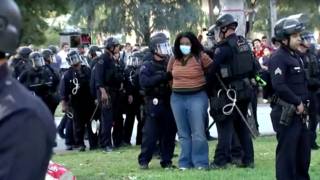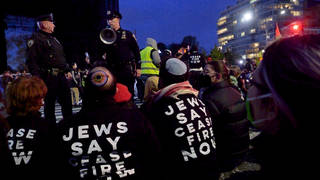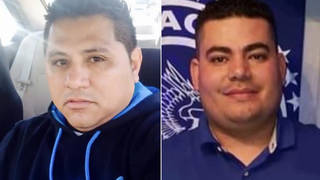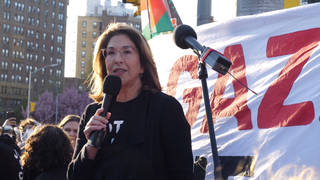
Related
Topics
Guests
- Valeria Luiselliaward-winning writer. Her latest book is Tell Me How It Ends: An Essay in 40 Questions. Her previous books include Faces in the Crowd, Sidewalks and The Story of My Teeth.
As President Trump continues to vow a crackdown against immigration and immigrants living inside the United States, we turn to a new book described by the Texas Observer as “the First Must-Read Book of the Trump Era.” The book is titled “Tell Me How It Ends: An Essay in 40 Questions” by Mexican-born author Valeria Luiselli. Luiselli is one of the most acclaimed young Mexican writers. She recently spent time as a volunteer interpreter for dozens of Central American child migrants here in the United States who risked their lives crossing Mexico to seek refuge in the U.S. For more, we speak with Valeria Luiselli.
Transcript
AMY GOODMAN: This is Democracy Now!, democracynow.org, The War and Peace Report. I’m Amy Goodman. We turn now to a book described by the Texas Observer as “the First Must-Read Book of the Trump Era.” The book is entitled Tell Me How It Ends: An Essay in 40 Questions, by Mexican-born author Valeria Luiselli. She’s one of the most acclaimed young Mexican writers. She recently spent time as a volunteer interpreter for dozens of Central American child migrants here in the United States who risked their lives crossing Mexico to seek refuge in the U.S. The book opens with the first question Luiselli has to ask each child she helped in immigration court: “Why did you come to the United States?” The book is being published as President Trump vows a broader crackdown on undocumented immigrants.
Valeria Luiselli, thank you so much for being with us.
VALERIA LUISELLI: Thank you so much for inviting me, Amy.
AMY GOODMAN: So, tell me what you did in immigration court.
VALERIA LUISELLI: Well, I did what a lot of volunteer—bilingual volunteers did in that period, and can still do right now, which was to simply serve as a bridge between kids coming in from Central America and lawyers that screen them. So, when the [ 2014 ] crisis erupted and the priority children’s docket was declared, meaning that all the kids’ cases were grouped together and bumped up in the priority list, meaning that they were now a priority in terms of deportation—
AMY GOODMAN: And, of course, this is during the Obama years.
VALERIA LUISELLI: This is during the Obama years, yeah. This is in 2014. So they were prioritized as cases, and they suddenly had, instead of one entire year to find a lawyer, only 21 days. So, organizations, nonprofits, such as The Door or AILA or Safe Passage and kind—a lot of organizations—those are just here in New York—got together, formed a group and came up with a questionnaire to screen children, so that they could get their stories and, once they had their stories, could form a case that then a pro bono lawyer could take on. And what I did was simply to serve as a bridge between those possible lawyers and the children, translating their stories into English.
AMY GOODMAN: So, where were you in court?
VALERIA LUISELLI: There was a room. It’s actually now disappeared. Last week, I spoke to one of the persons that I worked with from The Door, who told me that the room where we conducted screenings was a room provided by the court, was an empty room that could be used for children, to receive every child that came in for a screening, is now no longer available. So, the situation in court right now is more chaotic and difficult than ever. But there was a room in court where organizations could set themselves up and receive children.
AMY GOODMAN: And this was here in New York.
VALERIA LUISELLI: This is here in New York, in Federal—yeah, in Federal Plaza.
AMY GOODMAN: So, talk about how children frame their experience, what you were most moved by.
VALERIA LUISELLI: Well, everything that—everything is—everything in their experience is at once horrifying and moving and fills the person who’s listening to them with great admiration. I mean, the children that arrive here, one must remember, are also the children that made it, the children that made it through Mexico, which is—which is really like hell for Central American migrants. Eight out of 10 girls get raped along their journey, so much so that teens and adult women take contraceptive precautions even before they start the journey, because they assume they will be raped. Hundreds of thousands of people have disappeared, Central Americans. There are mass graves in Mexico being found every week, basically, with remains of people. And so, everyone knows that it’s really difficult to even just make it through Mexico, now more so because Peña Nieto, the Mexican president, and Obama signed agreements in which the U.S.—by which the U.S. has been pouring money into Mexico so that Mexico acts as a sort of chief deportator. And so Mexico has now been deporting many more migrants. So, when—these children, the ones that arrive in court, are the ones that make it through Mexico, that make it through their first screenings with Border Patrol and are put then in the ICE—in the icebox and then in a—in a shelter, and then finally arrive in court.
AMY GOODMAN: It’s called the “icebox”?
VALERIA LUISELLI: It’s called the—in Spanish, it’s usually referred to as the hielera, which is—which means “icebox.” And it’s because it—of course, because it’s the ICE facilities, but also because the icebox, or the hielera, is like a huge human refrigerator, where people freeze, are put under freezing temperatures and subject to very inhumane conditions.
AMY GOODMAN: Can you read something for us from your book, Tell Me How It Ends: An Essay in 40 Questions? We’re speaking with Valeria Luiselli, an award-winning writer, this book based on her interpreting for child migrants in New York immigration courts.
VALERIA LUISELLI: Sure. I’ll read—I’ll read a tiny fragment from an interview with very young, young girls.
“Often, my daughter asks me:
“So, how does the story of those children end, Mama?
“I don’t know how it ends yet, I usually say.
“My daughter often follows up on the story she half-hears. There is one story that obsesses her, a story I only tell her in pieces and for which I have not yet been able to offer a real ending. It begins with two girls in the courtroom. They’re five and seven years old, and they’re from a small village in Guatemala. Spanish is their second language, but the older girl speaks it well. We sit around the mahogany table in the room where the interviews take place, and their mother observes from one of the benches in the back. The little girl concentrates on her coloring book, a crayon in her right hand. The older one has her hands crossed as an adult might, and she answers my questions one by one. She is a little shy but tries to be clear and precise in her answers, delivering all of them with a big smile, toothless here and there.
“Why did you come to the United States?
“I don’t know.
“How did you travel here?
“A man brought us.
“A coyote?
“No, a man.
“Was he nice to you?
“Yes, he was nice, I think.
“And where did you cross the border?
“I don’t know.
“Texas? Arizona?
“Yes! Texas Arizona.”
That’s just a small fragment from—from an interview with two girls from Guatemala.
AMY GOODMAN: Now, there are official questions that you have to ask. Can you talk about question seven of the 40 official questions?
VALERIA LUISELLI: Sure. That’s “Did anything happen on your trip to the U.S. that scared or hurt you?” I mean, for me, as a Mexican, that’s—that’s the question that most fills me with shame, because your trip to the U.S. means basically what happened to you in Mexico, riding the Bestia or walking and—
AMY GOODMAN: And explain what you mean by the Bestia.
VALERIA LUISELLI: The Bestia is—that’s the way that the freight trains are called in Mexico. It’s not a single train. A lot of people think that it’s one single train. It’s actually three different train routes that connect southern Mexico, Chiapas, with the north of Mexico. So, a lot of migrants for many years have been riding atop the train cars of the Bestia. They’re called gondolas, like the Italian gondolas. That’s the way that they’re referred to in Spanish. They ride atop the gondolas to make it to the north, where they then cross the desert.
Now, because of Programa Frontera Sur, the plan that was signed between Obama and Peña Nieto, or the plan that Peña Nieto came up with after talks with Obama, and Mexico’s role in this process, a lot of people are not riding the Bestia anymore because it’s too—it’s too dangerous for them. There are too many immigration officials waiting there to hunt them down. So a lot of people are taking even more dangerous routes. They’re starting to open sea routes. People are now traveling on little boats, which is—I mean, we’ve seen what’s happened in the Mediterranean, which is a relatively small and calm sea. Imagine riding through the waves of the Pacific Ocean on small boats?
So, anyway, that question fills me with shame because of what happens to Central Americans in Mexico and the way they are treated not only by drug lords and assassins, but also the government, which is not following due process and not giving them the right they have to seek asylum in Mexico, if they wanted to, and is just deporting them without even giving them a chance to defend their case.
AMY GOODMAN: Valeria, you’ve said you want to change the language around how we think about immigration. That’s why you wrote this book. How do you want to change it? What is wrong with it?
VALERIA LUISELLI: Well, violence starts with language—right?—violence against people. But so does resistance, I think. And calling an undocumented migrant an “illegal,” for example, is something that a lot of people with good intentions do, because—because that’s the language. That’s the accepted language out there, just as slavery in the U.S. used to be called “our peculiar institution” instead of slavery. Deportation is called “removal,” the same way that putting Indians into reservations was called removal. Undocumented is called “illegal.” So, people, of course, for example, feel that they’re criminals, feel that they’re somehow lesser and not—not entitled to anything. If you call a person illegal, you—eventually they feel that they are a criminal, right? So, part of this book is rethinking the language around immigration.
Of course, pushing the idea that Sonia Nazario very brilliantly and bravely put forth years ago already, that these children coming from Central America are not—are not to be even seen as migrants, as young migrants, but as refugees, because of the situation that they are fleeing. They are trying to seek asylum here. They turn themselves in to Border Patrol and seek asylum. They’re not here trying to get in illegally. They don’t want to remain undocumented. No one does. It’s not the destiny that anyone really desires.
AMY GOODMAN: You’ve said something very interesting about Trump coming into office, that it has brought relief to immigration activists who have been working for so long, well beyond Donald Trump, saying—you’ve said that “for the first time in such a long time, the cultural elite and liberals and the more general population seem to be a lot more concerned.” So, under President Obama, which even his allies in the immigration community, those who worked inside and outside the White House, came to call the deporter-in-chief—
VALERIA LUISELLI: Yeah.
AMY GOODMAN: —there was not very—there was tremendous activism at the grassroots level, but acknowledgment of what was happening, the millions of people who were being deported, that didn’t really hit the corporate media radar, to say the least.
VALERIA LUISELLI: That is true.
AMY GOODMAN: What about this?
VALERIA LUISELLI: That’s very true. I mean, one must acknowledge the very good things that Obama did do in terms of immigration, such as getting the DACA passed through an executive order. But there’s a lot of things that he did not do and a lot of things that he did do that were very wrong, such as creating the priority juvenile docket, giving children, instead of a year to get a lawyer to defend themselves against deportation, after they had finally arrived in the U.S., giving them only 21 days. So, yes, there’s a lot to be criticized. And—
AMY GOODMAN: And many children, although they say that you can only stay in a detention facility for something like 21 days, they move them from one to the other. I mean, in New Jersey, you have people who have been held, families—
VALERIA LUISELLI: Yeah.
AMY GOODMAN: —for well over a year.
VALERIA LUISELLI: Yeah, exactly. Or in the iceboxes, people are not supposed to stay there for longer than 72 hours, and they often are left there for weeks and under terrible conditions. A few years ago, there was a scandal that, luckily, made it out into public knowledge, which was that children were given adult vaccinations for hepatitis, so they became very sick, 400, 200—I mean, I don’t remember the exact number, if it was 200. Between 200 and 400 children ended up hospitalized, because they were given this vaccination that was not for them.
So, yes, the Obama years were dark for immigrants. And liberal-thinking people, liberals did not have such a strong opinion. It was as if it was something that we had to talk about almost in a hush, because, comparatively, Obama was so much better than many other presidents, right? But now it seems that, finally, immigration is back on the table, and people that weren’t so concerned or weren’t so active are now active.
AMY GOODMAN: Can you talk about Manu, a teenager from Honduras who you worked with?
VALERIA LUISELLI: Yes, I can. Manu—I remain close to Manu. That’s not his real name, of course, but—and he’s kind of angry with me, because he wanted his real name to be in the book. But I asked his lawyer—we talked to his lawyer, and his lawyer said no. Until he has a green card, he—even though he now has a SIJ, so he has a legal status right now, it’s very frail. He can easily be denied a green card. So, because he doesn’t have a green card yet, she said that it wasn’t recommendable that we used his real name in the book. So I put a picture of him in the book, but his face is not clear. You can just see the silhouette of his body. And he wrote to me. He wrote—he writes WhatsApp messages to me, saying, “Valeria, this picture’s really nice, but you can’t really see my face.” So he’s a—I mean, he’s one of the—he was the first case I ever translated in court. And he’s the person with whom I have a sort of an ongoing relationship.
He now comes to Hofstra University, where I work, every week, to have English one-on-one classes with a student of mine, Lexi Cohan, who’s one of the TIIAs. The TIIAs are a group of students at Hofstra that got together, after a class I gave, and decided to form the Teenage Immigrant Integration Association. And they now receive teens once a week, on a one-to-one—in a one-to-one model. And the teens then receive English lessons with them. Some of them are getting college application help. And the idea is that a more political wing of the TIIA will also start talking to kids about activism and about civil rights and about ways that they can not only themselves feel more empowered in their communities, but eventually also go back to their communities and talk about these—about these things.
AMY GOODMAN: Talk about the significance of the wall. And does it—do children talk to you about it? You are talking about Manu, not his real name. There’s the discussion of the wall on the southern border, of U.S. and Mexico, but there’s also a wall being discussed on the southern southern border. That’s Mexico and Honduras. The Weekly Standard, the conservative publication, had a recent headline, Will Mexico—”Will Mexico Build a Wall on Its Southern Border and Make Trump Pay for It? Maybe.”
VALERIA LUISELLI: I mean, Mexico is no example of a humanitarian treatment to people from Central America and even to treatment with basic dignity. For many years, Mexico was an example of a country that was very open to receiving refugees and exiles from all over the world. There was an important Lebanese migration in the '70s. There was, of course, the big Spanish migration during the Franco years, and the Argentinian, Chilean, Uruguayan, Brazilian migration during the dictatorships in the Southern Cone. But Mexico has never opened its doors to Central Americans or to Haitians now. And I think it's a matter of a fundamental racism. I think that Mexico was happy to bring in whiter people, para blanquear, we say, to sort of—to white-ify the country, but has never received Central Americans. It is, after all, a racist issue.
AMY GOODMAN: That border, by the way, would be built on the Mexico-Guatemala border.
VALERIA LUISELLI: Yeah, of course.
AMY GOODMAN: But, finally, we have 10 seconds. Tell Me How It Ends, the title, where you got it?
VALERIA LUISELLI: My daughter keeps on asking me the same question, even now. She always wants to know what’s going on with the children that I work with and what their stories are. And she always wants to know how the story ends. But, unfortunately, there is no—there is no ending. There’s no happy ending.
AMY GOODMAN: Well, Valeria Luiselli, thanks so much for being with us, award-winning writer. Her latest book, Tell Me How It Ends: An Essay in 40 Questions.
That does it for our broadcast. We’ll be on a speaking tour starting this weekend, and we’ll be covering the march on science on the 22nd, the march on climate change on the 29th in Washington. Check our website.












Media Options